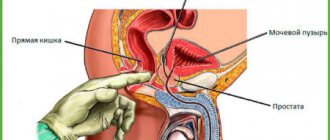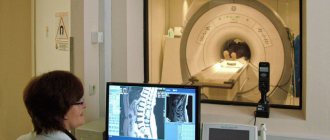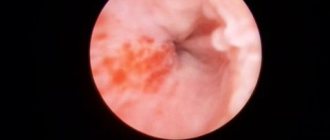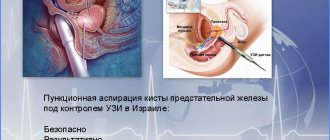Why is TRUS performed?
When conducting a transrectal ultrasound examination, it is possible to diagnose many pathological conditions, such as:
- Prostatitis in acute or chronic form;
- Vesiculitis (inflammatory process in the seminal vesicles);
- Epididymitis (inflammation of the epididymis);
- Hyperplasia (enlargement) of the prostate gland;
- Neoplasms of the prostate gland (both benign and malignant);
- Infectious and inflammatory complications (abscesses, cellulitis).
Features of the study
In order for the study to provide the doctor with as much useful information as possible, it is important to carefully prepare for it. Before undergoing an ultrasound of the bladder and prostate, a man should adhere to a special diet for several days: do not eat food that can cause the formation of a large amount of gas or disrupt the functioning of the intestines.
How to prepare for a prostate ultrasound in a man? In the evening the day before the test, you should do a cleansing enema. Before the study, it is forbidden to eat any food. If therapy is carried out after lunch, then a light breakfast is allowed. Photos of how a prostate ultrasound is performed in men can be seen below.
Many men refuse to visit a doctor and have an ultrasound scan for a long time, so they try to avoid it in every possible way. In fact, there is nothing terrible in the procedure. It should be noted that this survey method is considered quite reliable and effective. Features of an ultrasound scan of the male prostate bladder:
- the patient takes off his clothes (pants and shoes), lies on his side, bends his legs and presses them to his stomach;
- the doctor uses a specialized sensor, puts a condom on it and lubricates it with gel, then inserts the device into the rectum;
- The specialist carefully and slowly moves the rectal sensor to the level where the prostate is located.
During therapy, the patient may experience unpleasant symptoms, but not pain. The diameter of the sensor reaches only 1.5 centimeters, so the intestines cannot be damaged even in the case of deep immersion (from 5 to 7 centimeters). In a relaxed state, a person does not experience any discomfort or unpleasant sensations.
Indications for prostate examination.
Transrectal ultrasound examination is prescribed if the patient has certain complaints or if abnormalities in laboratory parameters are detected. The need to prescribe TRUS arises for the differential diagnosis of infertility in men with elevated levels of prostate-specific antigen, which may indicate prostatic hyperplasia or the presence of any neoplasms in it. In addition, it is considered appropriate to prescribe this study if men have complaints of frequent or difficult urination or nocturia.
Which is better - ultrasound or TRUS?
Both ultrasound and TRUS are instrumental diagnostic methods based on the difference in acoustic impedance of the tissues of the human body. As a result, the ultrasonic waves coming from the sensor, undergoing changes, are reflected or scattered, giving a detailed picture of the location and structure of the internal organs. Conventional ultrasound examination is performed transabdominally or through the anterior abdominal wall, TRUS is performed through the rectum. For diagnosing pathologies associated with the prostate gland, undoubtedly, the most informative method is transrectal ultrasound. Firstly, this is due to the proximity of the prostate and rectum, which gives a more detailed picture of its size, structure and homogeneity. Secondly, when performing TRUS, it is possible to examine the seminal vesicles, which is impossible to do with a transabdominal examination.
Preparation for TRUS of the prostate.
In order to avoid any difficulties with conducting a transrectal ultrasound examination, and also to ensure that the resulting result is as reliable as possible, it is necessary to follow some rules before performing it. A few days before TRUS, it is worth adjusting your diet, which should not include gas-forming foods (fresh fruits and vegetables, baked goods, legumes, dairy products), since if there is a large amount of gas in the intestines, the picture will be blurred. Also, two or three days before the expected day of the study, you should stop taking aspirin-containing and other blood-thinning medications. If, for medical reasons, this cannot be done, you should notify a specialist in advance. Before performing a transrectal ultrasound examination, it is necessary to empty the intestines so that there are no obstacles to the passage of the transducer through the rectum. This can be done in two ways: either by taking a laxative the day before, or by using a cleansing enema on the day of the procedure. During TRUS of the prostate, the bladder must be full, which is achieved by drinking one liter of water one hour before the examination. In certain pathologies, there is a need to determine the residual volume of urine after emptying the bladder, then the patient is examined again after going to the toilet.
How is transrectal ultrasound performed?
Transreutal ultrasound examination of the prostate gland is performed with the patient lying on his left side with his knees brought up to his chest. This position provides the most informative access with the ability to visualize the prostate from several sides. The endoscopic ultrasound sensor is pre-treated and a special gel is applied to it, which ensures painless penetration into the rectum. The depth of insertion does not exceed eight to ten centimeters.
Decoding the results.
The results of the research, as a rule, are not long in coming. A description of a transrectal ultrasound examination of the prostate gland is given to the patient almost instantly. In addition to the size, structure and contours of the prostate gland, you can find the presence or absence of any neoplasms, the condition of the seminal vesicles, and an assessment of the degree of bladder emptying. In addition, along with the main indicators, the doctor during the examination evaluates the condition of the rectum and periprostatic tissue.
Contraindications to TRUS.
Like all diagnostic procedures, transrectal ultrasound examination of the prostate gland has its contraindications. This examination is not carried out in the presence of inflammatory processes in the rectum (praktitis, parapraktitis), varicose hemorrhoidal veins in the acute stage, cracks and ulcerative defects in the anal area, or the general serious condition of the patient. However, these contraindications cannot be called absolute. Since, for health reasons, this study can be carried out regardless of the presence of these pathologies.
Today, prostate diseases in men occupy a leading position. A screening method for identifying any pathology related to this area is the determination of prostate-specific antigen. However, this indicator only confirms or refutes these assumptions. And in establishing and verifying the diagnosis, an examination such as TRUS undoubtedly plays a huge role. And, as you know, a correct diagnosis is half the treatment.
How to prepare for an ultrasound of the prostate and bladder
- A week before the ultrasound, stop taking blood thinners;
- For 2-3 days, limit food that leads to excess gas formation;
- On the day preceding the ultrasound, finish your meal with a light dinner at 18-19 hours. On the day of the study, only a light breakfast is allowed;
- Do a colon cleansing enema 2-3 hours in advance;
- An hour before the diagnosis, drink 700 ml of water and do not urinate.
At the Heratsi Medical Center, ultrasound of the prostate and bladder is performed using expert-class equipment by highly qualified specialists at a competitive cost. No extra charges for class and professionalism. Our motto is high quality medical services accessible to everyone.
Ultrasound cost
The cost of such a procedure will directly depend on the region of residence, the chosen clinic, as well as the level of professionalism of the doctor. The last factor is considered the most important, since the correctness of the decoding, its completeness and reliability will depend on it.
Price for ultrasound examination in different cities of the country:
- Moscow – from 1200 to 1600 rubles;
- St. Petersburg - 1200 rubles;
- Yekaterinburg – 1000 rubles.
In general, the ultrasound procedure is considered affordable, fast, safe and informative. Its results are trusted by doctors around the world. If a patient is prescribed such a procedure, then he should carefully consider the choice of clinic, doctor and preparation recommendations, since it is very important for treatment and prevention.
Pros of the procedure
The prostate ultrasound method has many advantages:
- the accuracy and safety of the procedure is ensured;
- universality (the study is applied to many diseases);
- it is possible to perform a biopsy;
- absence of unpleasant pain and accessibility.
When conducting a study, if necessary, the doctor takes tissue from the prostate gland, which helps him obtain additional information.
Many doctors trust the results of ultrasound examination of the organ. Regardless of the method used in the study, the doctor receives maximum reliable and accurate information, which helps to make the correct diagnosis and carry out comprehensive treatment.
Ultrasound examination can be carried out both at the initial stage of the development of the disease and during treatment measures to determine their effectiveness. Such a study is a good assistant in identifying the disease at an early stage of its course and in developing complex treatment.
Indications for testing
When a patient presents with certain complaints and a characteristic clinical picture, the doctor may suspect the presence of a developing pathological process. To clarify the diagnosis, a number of laboratory tests may be required, but for a more informative examination and obtaining reliable results, ultrasound diagnostics of the prostate gland is prescribed.
Indications for prostate ultrasound are:
- Painful sensations in the lower abdomen.
- Pain or discomfort when urinating.
- In the presence of unusual pathological discharge during urination.
- If you suspect the presence of inflammatory processes in the pelvic cavity in men.
- For problems with reproductive function.
- If you suspect the presence of prostate tumors.
Transabdominal ultrasound
Before undergoing a transabdominal ultrasound examination, it is important for a man to fill his bladder so that he does not feel a strong urge to urinate. This condition is considered important to facilitate ultrasound and better view the general condition of the prostate. Procedure technique:
- A man lies down in a medical office on a special sofa, exposing his stomach.
- Next, the doctor treats the patient’s abdominal skin with a special gel. With its help, the air gap between the ultrasound sensor and the patient’s skin is eliminated.
- Next, the sensor is slowly moved over the skin of the abdomen, and the doctor, using special equipment, examines the physiology of the pelvis in all details. After a detailed examination of the prostate gland, the doctor determines all changes and problems. Often, the specialist also evaluates the severity of bladder problems. The therapy time is about 10 minutes, after which the gel is wiped off, and after 5-7 minutes the patient receives the examination result.











